Latest posts by (see all)
- The Best Things to Do in Tulsa - June 26, 2020
- The Most Interesting Things to Do in Springfield Mo - June 15, 2020
- Best Things to Do in Salt Lake City - May 26, 2020
- 10 Best Websites for Playing Online Games - May 22, 2020
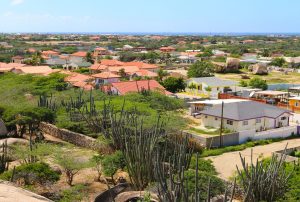 The formula for the popularity of the Caribbean island-state of Aruba is simple, but no less effective: good sandy beaches, clear coastal waters, great entertainment opportunities (at the level of Cancun), educational excursions, and shopping. Tourists of all ages come here. Many of them are travelers who, step by step, discover more and more new faces of the Caribbean islands.
The formula for the popularity of the Caribbean island-state of Aruba is simple, but no less effective: good sandy beaches, clear coastal waters, great entertainment opportunities (at the level of Cancun), educational excursions, and shopping. Tourists of all ages come here. Many of them are travelers who, step by step, discover more and more new faces of the Caribbean islands.
Contents
- Thing to do number 1: Go to the Arikok National Park
- Thing to do number 2: California Lighthouse
- Thing to do number 3: Have a Look at the Ayo Rock Formation
- Thing to do number 4: Visit Charlie’s Bar
- Thing to do number 5: Have a Great Time at the Hadikurari Beach
- Thing to do number 6: Go to Iguana Beach
- Thing to do number 7: Go to the Renaissance Beach
- Thing to do number 8: Go to the Alto Vista Chapel
- Thing to do number 9: Have a Look at the Ruins of the Gold Field
- Thing to do number 10: Go to See Yamanote Mountain
- Thing to do number 11: See the Most Famous Aruba’s Chapel-the Lourdes Grotto Chapel
- Video
Thing to do number 1: Go to the Arikok National Park
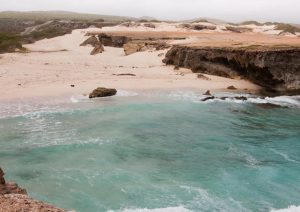 In the southern Caribbean, not far from Venezuela, there is the small island of Aruba, which is one of the Lesser Antilles. The area of the island is 193 square km, it inhabits a little more than 100 thousand people. This public entity is part of the Kingdom of the Netherlands as a subject of the Federation. The capital of Aruba is Oranjestad.
In the southern Caribbean, not far from Venezuela, there is the small island of Aruba, which is one of the Lesser Antilles. The area of the island is 193 square km, it inhabits a little more than 100 thousand people. This public entity is part of the Kingdom of the Netherlands as a subject of the Federation. The capital of Aruba is Oranjestad.
18% of the island’s territory is occupied by the famous Arikok National Park – a conservation zone between the Yamanota Upland (188 m) and Arikok Hill (176 m), which block the park from northeast winds. Due to this, and also due to the soil rich in mineral substances, this area has a rich flora and fauna. Some species of animals and plants live only in this area. Several species of snakes, as well as birds (one of the species of owls and parrots) can be found only in the reserve. Divi-divi trees, Quihi, various types of aloe, cacti, and tropical flowers grow here.
Arikok Park is also interesting for its historical monuments, such as:
- the remains of the Dutch settlements in Masiduri,
- ancient plantations in Prince Valley,
- the ruins of gold mining mines in Miralamar.
Interesting: In one of the caves – Fontaine, petroglyphs left by Arawak Indians were found. There are other caves in the park: Guadiric and Hulib “Tunnel of Love”.
Back
Thing to do number 2: California Lighthouse
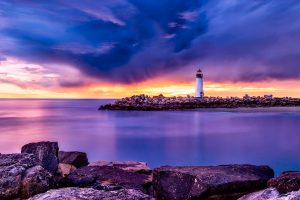 In the northwestern part of the island, on a hill called Hudishibana, a white stone lighthouse rises 30 meters high. The California lighthouse got its name in memory of the California ship, which crashed in these places in 1891. The ship sailed from England to Central America, carrying passengers and goods for sale. During the wreck, the crew threw most of the goods overboard to lighten the ship. The locals picked them up, dried them and sold them for a long time at the local market in Oranjestad. As they say, there would be no happiness, but misfortune helped.
In the northwestern part of the island, on a hill called Hudishibana, a white stone lighthouse rises 30 meters high. The California lighthouse got its name in memory of the California ship, which crashed in these places in 1891. The ship sailed from England to Central America, carrying passengers and goods for sale. During the wreck, the crew threw most of the goods overboard to lighten the ship. The locals picked them up, dried them and sold them for a long time at the local market in Oranjestad. As they say, there would be no happiness, but misfortune helped.
- Next to the lighthouse, in the former caretaker’s house, there is now a restaurant called the “Restaurant by the White Lighthouse”. At the entrance to the restaurant there is a sign that shows the history of the lighthouse.
- The white candle of the lighthouse, proudly soaring up to the blue sky, looks very picturesque, therefore this image has become a real trademark of Aruba.
Interesting: People come here to enjoy the views of the west coast of Aruba, which are especially beautiful in the rays of the setting sun.
Back
Thing to do number 3: Have a Look at the Ayo Rock Formation
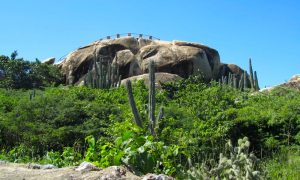 Aruba is a beautiful, unusual, full of amazing surprises, island in the Caribbean. Resting here is not only pleasant, but also amazingly interesting. The main mystery of Aruba in the general opinion can safely be called the Ayo Rock area.
Aruba is a beautiful, unusual, full of amazing surprises, island in the Caribbean. Resting here is not only pleasant, but also amazingly interesting. The main mystery of Aruba in the general opinion can safely be called the Ayo Rock area.
- Passing through a stone gate with a thatched roof, you find yourself on a vast hilly area, “populated” by rocks and huge boulders. It is still unknown where these stone formations came from here, since their composition is foreign to the island. On some boulders, the remains of petroglyphs (carved on stone images) of unknown origin are preserved.
- Most likely, the drawings were left by an ancient civilization that lived on this earth for a very long time. This version is also indicated by the clearly geometrically clear arrangement of huge boulders, in the form of concentric circles. Perhaps, the descendants of this civilization survived until the 15th century AD, that is, until the moment when these lands were discovered by the Spaniards.
After all, at first the Antilles were called Islas de los Gigantes (Spanish), “the islands of the Giants,” because the local population significantly exceeded the size of the Spanish sailors.
Interesting: Are these giants placed stones in circles, or is it a fad of nature, which sometimes works wonders that we cannot even imagine? To find your answer to this question, you need to go to Aruba and see everything with your own eyes.
Back
Thing to do number 4: Visit Charlie’s Bar
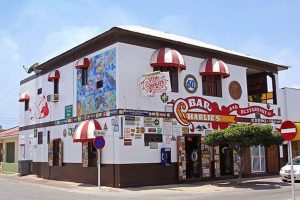 Locals say about Charlie’s bar-restaurant: “If you haven’t been to Charlie’s, you don’t know Aruba!” The bar has been open to visitors since 1941 and today this place is to the liking of both ordinary residents and well-known people – artists, politicians, and even royals. Among the latter, it even has its patrons.
Locals say about Charlie’s bar-restaurant: “If you haven’t been to Charlie’s, you don’t know Aruba!” The bar has been open to visitors since 1941 and today this place is to the liking of both ordinary residents and well-known people – artists, politicians, and even royals. Among the latter, it even has its patrons.
In 1977, the Queen of Holland awarded Charles Browns Sr. the “Order of the House of Orange” (which means a kind of knighting) for his help during World War II and his many years of contribution to the development of a food culture.
Bar Charlie’s stands on the very shore of the Caribbean Sea, 30 meters from the place where sailors usually go ashore. This ensures a steady flow of customers. The atmosphere of the bar is created from a wide variety of objects of various styles and directions:
- oil paintings,
- personal items of famous people,
- national and ethnic souvenirs, awards, photographs.
The bar has its own mini-hotel with several rooms, ready to shelter those who prefer a quiet relaxing holiday away from the bustle of the city. Today, Bar Charlie’s is recognized as one of the ten best bars in the Caribbean.
Interesting: Here are the best dishes of intercontinental cuisine: everything from giant shrimp to steaks and fillets, fresh seafood, a wide selection of snacks at your disposal. The menu is very diverse and is prepared every day.
Back
Thing to do number 5: Have a Great Time at the Hadikurari Beach
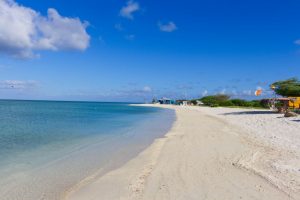 This beach is located on the northwestern edge of Aruba Island, close to the Marriot Aruba Hotel and Casino Stellaris. Here, you will find many small thatched-roofed huts, which gave the name to the beach – Hadikurari Beach – Fisherman’s Hut.
This beach is located on the northwestern edge of Aruba Island, close to the Marriot Aruba Hotel and Casino Stellaris. Here, you will find many small thatched-roofed huts, which gave the name to the beach – Hadikurari Beach – Fisherman’s Hut.
- Strong warm winds constantly blow here, which creates a real paradise for windsurfers and kiters.
- The shallow coastal rainbow waters are also pretty good for fun snorkeling.
- On the shore, there is a beautiful restaurant with the same name Hadikurari, where you can have lunch, drink a cocktail or hide from the scorching sun at any time.
Like all Aruba beaches, this beach is absolutely open to everyone at any time of the year. There are always a lot of people here, but at the beginning of July it is especially crowded because at this time the windsurfing tournament takes place here.
Interesting: From the restaurant’s open terrace, you can admire the beach itself and beautiful views of the ocean and windsurfers soaring above the waves.
Back
Thing to do number 6: Go to Iguana Beach
 Iguana Beach is one of two beaches on the private Renaissance island, located in the Caribbean Sea off the west coast of Aruba south of Oranjestad. The island is a narrow and very elongated strip of land. It belongs to the resort of the same name. The beach is located in the northwestern part of the island opposite the runway of Queen Beatrix International Airport.
Iguana Beach is one of two beaches on the private Renaissance island, located in the Caribbean Sea off the west coast of Aruba south of Oranjestad. The island is a narrow and very elongated strip of land. It belongs to the resort of the same name. The beach is located in the northwestern part of the island opposite the runway of Queen Beatrix International Airport.
- Iguana beach, like the island itself, is private. Accordingly, its infrastructure and service level are at a high level.
- The beach is sandy, clean, with large palm trees giving a natural shade. It is equipped with a breakwater, so swimming in its area is absolutely safe.
Interesting: The beach got its name from a dozen iguanas that live on it the size of a human hand.
Back
Thing to do number 7: Go to the Renaissance Beach
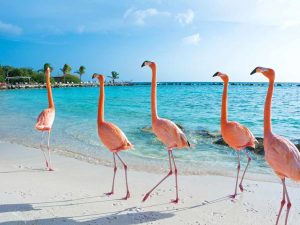 Renaissance Beach is a beach in the western part of Oranjestad, the administrative center and the largest city of Aruba. The beach belongs to the hotel of the same name and has a high degree of comfort for vacationers.
Renaissance Beach is a beach in the western part of Oranjestad, the administrative center and the largest city of Aruba. The beach belongs to the hotel of the same name and has a high degree of comfort for vacationers.
- The Renaissance beach is not large in size, but surprisingly comfortable. A strip of snow-white sand surrounds the lagoon, connected to the sea only by a narrow water “neck”, through which a pedestrian bridge is thrown.
- The bottom of the lagoon is sandy, the depth is shallow, and the water warms up unusually quickly. You can swim from the side of the lagoon that faces the sea, but there you have to go into the water on the rocks.
In front of the Renaissance Beach, there is a private island owned by the hotel. You can get here in 7-8 minutes using a water taxi. The beaches are equipped here both for family vacations and exclusively for the adult audience.
Interesting: From the north-east side, a wonderful park named after Queen Wilhelmina adjoins directly to the beach. This is four and a half acres of beautifully manicured land with green lawns, flowering shrubs, with mighty trees, whose crowns save their shadow from the heat.
Back
Thing to do number 8: Go to the Alto Vista Chapel
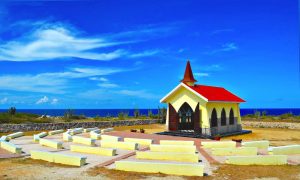 Alto Vista Chapel is a small Catholic temple, also known as the Pilgrim Church. It stands on a hill, 8 km northeast of the city of Nord. The church is painted on the outside in a very bright yellow color and is visible from afar.
Alto Vista Chapel is a small Catholic temple, also known as the Pilgrim Church. It stands on a hill, 8 km northeast of the city of Nord. The church is painted on the outside in a very bright yellow color and is visible from afar.
The Alto Vista Chapel was built in 1952 on the site of the Catholic Church, founded in 1750 by missionary Domingo Antonio Silvestre from Santa Ana de Coro, Venezuela. The territory where the chapel is located is considered the very place where the conversion of the Aruba Indians to Christianity began, here the village was founded by missionaries. Some facts about Alto Vista Chapel:
- Near the chapel is Arikok National Park and California Lighthouse.
- In the late 18th – early 19th century, during the plague epidemic, many residents died, while the rest left the settlement and left for Nord. The church was empty and completely destroyed by 1816. Surprisingly, the wooden cross survived. It is currently located at St. Anne’s Church in Nord. The design of the new chapel was developed in 1952 by the Dutch engineer Hille.
- Inside, there are several crosses, one of which is noteworthy – this is an old Spanish cross, it is one of the oldest European works of art in the Caribbean.
Interesting: The building does not have any stained-glass windows, but an altar with a statue of the Virgin Mary and a very calm atmosphere favor prayer. The border of the old chapel is marked with stones, several graves have also been preserved, among them the burial places of Domingo Antonio Sylvestre and Miguel Enrique Albares.
Back
Thing to do number 9: Have a Look at the Ruins of the Gold Field
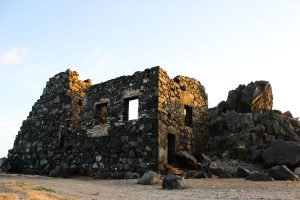 The history of the island is divided into two periods: before colonization and after it. Until the Europeans suspected the existence of Aruba, the island lived its harmonious life. The indigenous population of the island was Arawak Indians, who were tall, significantly superior to the growth of Spanish sailors. However, after the arrival of the white man, the Arawakians were taken out for hard work, from which they died as a whole tribe, leaving the island uninhabited.
The history of the island is divided into two periods: before colonization and after it. Until the Europeans suspected the existence of Aruba, the island lived its harmonious life. The indigenous population of the island was Arawak Indians, who were tall, significantly superior to the growth of Spanish sailors. However, after the arrival of the white man, the Arawakians were taken out for hard work, from which they died as a whole tribe, leaving the island uninhabited.
- The Spaniards soon ceded Aruba to the Dutch, those to the British. The latter did not remain masters here for long, losing the rights again to the Dutch, who still own the island.
- At first, Aruba was used mainly for agricultural purposes, but the situation changed in 1824, when the boy Willem Raismin accidentally found gold. In a short time, a mine was built for gold mining. The field turned out to be not too rich and in 1914 the activities for its development were discontinued and did not resume.
Interesting: But the ruins of the gold mine in Miralamar have survived to this day, and therefore we can see with our own eyes what was here almost 2 centuries ago.
Back
Thing to do number 10: Go to See Yamanote Mountain
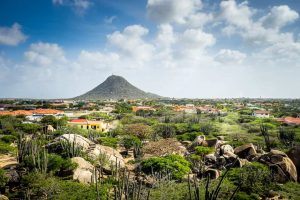 Yamanote is a mountain on the south coast of the island of Aruba – one of the most picturesque and curious islands in the Caribbean. Mount Yamanote owns a local absolute altitude record of 188 meters above sea level. The mountain is located on the territory of the Arikok nature reserve.
Yamanote is a mountain on the south coast of the island of Aruba – one of the most picturesque and curious islands in the Caribbean. Mount Yamanote owns a local absolute altitude record of 188 meters above sea level. The mountain is located on the territory of the Arikok nature reserve.
- Mount Yamanote is not only extremely picturesque and worthy of attention in itself, but also allows you to capture almost the entire island in all its glory from its peak. In turn, the mountain itself can be seen from anywhere in the island. As already mentioned, Yamanote is located on the territory of the Arikok nature reserve – a vast territory characterized by an abundance of flora and fauna.
- Due to the fact that the mountain obscures the protected lands from the destructive effects of northeast winds, a unique microclimate has formed here, which creates favorable conditions for the development of flora and fauna.
Interesting: Yamanote, as a natural barrier to the winds, is not only one of the factors that allows the plants and animals that inhabit the island to survive and develop, but it is also a habitat for many of them. In particular, donkeys and wild goats live on its slopes, often, here, you can also find Aruba parrots.
Back
Thing to do number 11: See the Most Famous Aruba’s Chapel-the Lourdes Grotto Chapel
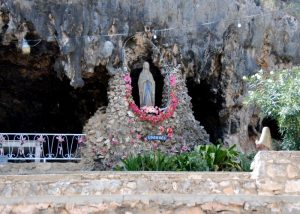 The Lourdes Grotto Chapel is located near San Nicholas, which is located in the southern region of Aruba. Local residents in honor of the 150th anniversary of the first appearance of the Virgin in the city of Lourdes (France) carved a grotto in the rock, where they placed a statue of St. Mary. The statue weighed approximately 700 kg. Some interesting facts from the history of this place:
The Lourdes Grotto Chapel is located near San Nicholas, which is located in the southern region of Aruba. Local residents in honor of the 150th anniversary of the first appearance of the Virgin in the city of Lourdes (France) carved a grotto in the rock, where they placed a statue of St. Mary. The statue weighed approximately 700 kg. Some interesting facts from the history of this place:
- This chapel was named after the 14-year-old girl from Lourdes, Bernadette Sibiru, who saw the Virgin Mary 18 times in one of the grottoes near the city – the Chapel of the Grotto of Lourdes. After she told her mother that the Virgin was there, the girl was forbidden to come to the grotto. By the way, this girl’s sister and her friend, who were next to her in the grotto when the Most Holy Virgin Mary appeared to her, did not see or hear anything.
- A few days later, the girl was still allowed to return to the grotto for new meetings with the Mother of God. Each of its appearance, the Virgin transmitted Bernadette her new message. At first, the Catholic Church did not recognize these phenomena as genuine, and as a result, Bernadette was sent to the monastery, where she became a nun.
- In 1860, the Catholic Church released its own studies and announced that the Virgin Mary had indeed appeared Bernadette Subirou. Pope Pius XI canonized her, and she was declared “Saint Bernadette.” Now, every February 11th, a procession of Catholic parishioners is sent from St. Teresita’s Church in San Nicholas to Lourdes Grotto Aruba to celebrate Mass at this religious site.
Interesting: If you find yourself next to the statue of the Virgin, then next to you will see a small statue of Bernadette, kneeling and praying in front of the Blessed Virgin Mary. The Chapel of the Grotto of Lourdes is a beautiful and quiet place that must be visited. Its healing power is certainly much less than that of the Grotto in Lourdes, where Bernadette the Virgin was, but it is rightfully one of the most striking symbols of respect for the Blessed Virgin Mary on the island of Aruba.
Back